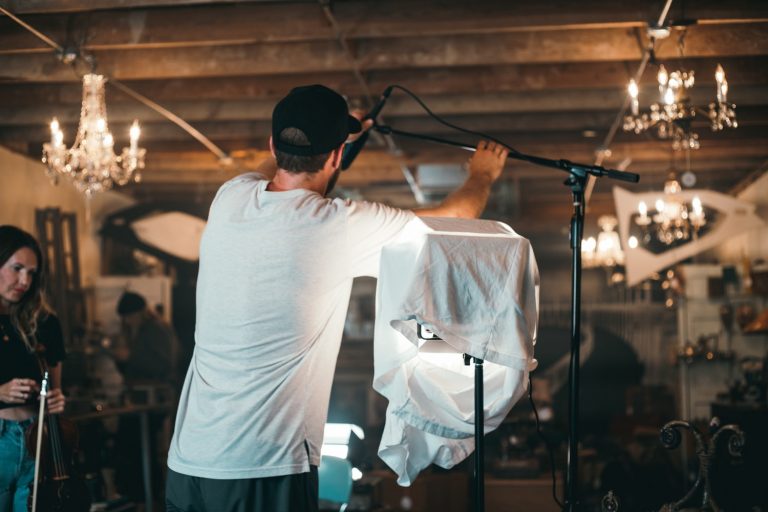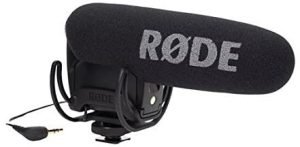If you’re a producer or sound engineer that needs to use microphones for any project, you probably don’t need an introduction to the best boom microphones.
Here is a list of the best boom microphones that should cover any project.
They are compact, portable, and highly durable; they feature exceptional sound fidelity, and they come with several accessories to help make your life easier in the studio or on location.
What Exactly is a Boom Mic?
The term “boom mic” can be a bit misleading. After all, boom microphones are usually just as small as any other microphone––in fact, they are sometimes smaller! The word “boom” in this case is used to describe the way that the mic is held.
Boom microphones are typically used during video production and in TV studios. You can also find them being used to recording in music studios, however.
Table of Contents
How to Choose a Boom Microphone for Recording
1. Audio Quality
One boom microphone is all you need to get good sound quality and be able to record audio at a variety of places. A single microphone can be used for multiple purposes, including recording music, speech recording, and voiceovers.
2. Portability
A microphone’s ability to be moved around will help you with your work when you need to move around a lot for different scenes. For example, you can move the mic to different places in order to get a better view of the subject matter.
Having a microphone that’s easy to use will make it easier for you to work efficiently. For example, you’ll be able to control the sound level and choose the right settings much more easily.
This microphone is great for recording small details that you need to hear clearly – like your own voice if you’re trying to record narration or dialogue.
3. Frequency Range
The most important factor is the microphone’s frequency range. A mic that works well on a wide range of frequencies will make the recording process much easier.
4. Impedance
The next important factor is the microphone’s impedance. Poorly designed microphones can have this problem, especially when they’re being used with amplifiers and other equipment. Ultimately, this matters because it determines how quickly the mic produces sound. It is particularly important because it can affect your ability to hear yourself during recording sessions over headphones or other speakers (or if you’re using a mixer or computer interface).
5. Noise Reduction
Another feature to consider is noise reduction. This helps to block out outside sounds and makes it easier for you to work efficiently and clearly.
6. Durability
The last factor that’s worth considering is the mic’s durability. If you’re going to be using your microphone a lot, it must be able to stand up to the test of time.
———————————————————————————————————————————–
Related Guides:
———————————————————————————————————————————–
7 Best Boom Microphones for Filming Outdoors
No products found.
1. Rode Video Mic Pro
No products found.
The Rode Video Mic Pro is a best budget microphone for any kind of digital video recording studio. This microphone has an internal shock mount and a highly flexible boom pole that can be extended to reach out about three feet. The microphone is easy to mount on cameras. It uses a 3.5mm XLR input, and offers an audio signal that is at least comparable to the one from the built-in microphones in most camcorders. This microphone may not be the best boom microphone for DSLR, but it produces good quality audio and is a good deal for video-makers on a budget.
2. Audio-Technica ATR-6550
No products found.
The Audio-Technica ATR-6550 is a great cheap boom microphone for those on a budget but looking for a good quality of audio. This microphone, when stretched to its full length, can reach out over six feet and is highly flexible. The body of this microphone is made of strong metal and fits well into the hand of the user. It can easily mount onto camcorders and DSLR cameras as it uses the standard XLR input. The Audio-Technica ATR-6550 is not the best boom microphone for DSLR, but it is a good bargain at this price range and produces excellent audio quality.
3. Rode NTG3
No products found.
The Rode NTG3 Condenser is one of the best boom microphones for DSLR cameras because of its three feet long cable that allows great flexibility to the camera operator. The microphone can be easily mounted on a DSLR or camcorder. This microphone is highly recommended for video makers who need a quality camera microphone for audio recording. It is also used by professional videographers due to its high quality sound and its impressive ability to pick up low-frequency sounds.
4. Audio-Technica AT897
No products found.
The Audio-Technica AT897 is a good budget boom microphone for video recording. This microphone has a flexible boom that is made of metal and can be extended up to 3 feet in length. It comes with adjustable clip and an XLR input. The audio signal produced by this microphone is at least comparable to the one from the built-in microphones of most camcorders. The Audio-Technica AT897 is recommended for DSLRs or camcorders that have XLR inputs.
5. Sennheiser MKH416-P48U3
No products found.
The Sennheiser MKH416-P48U3 is a professional grade boom microphone for DSLR cameras. This microphone can be stretched up to 3 feet in length. It comes with a nickel based connector and a reinforced tie arm. Its audio signal is comparable to that produced by the audio track recorded onto the video camera itself. The microphone does not come with an XLR input, but this should not be much of a problem as most DSLRs come with XLR inputs built in.
6. Deity V-Mic D3
No products found.
The Deity V-Mic D3 is a microphone with a very long cable that allows the user to stretch the microphone up to almost six feet. It is highly flexible and can be mounted on most DSLR cameras or camcorders. It uses an XLR input and has a metal body which makes it durable. This traditional boom microphone can pick up sound as well as produce audio quality similar to that of the one recorded by its built-in microphones. The Deity V-Mic D3 is a good boom microphone for DSLR cameras.
7. Sennheiser MKH 60
No products found.
The Sennheiser MKH 60 is the best microphone for DSLR cameras, which is considered as the best boom mic for Canon 5D Mark III, and also for Canon 7D. It has a condenser capsule with a low self-noise level and extended frequency response (20Hz to 20 kHz). It comes with a 4.8mm screw-terminated unbalanced output, as well as an XLR connector, and it can be attached to the camera without requiring any additional accessories. This microphone is highly recommended for DSLR cameras that have XLR inputs and in cases where no other external microphones are required.
FAQs
What is the best type of boom microphone?
The type of microphone that is used on a boom pole is often determined by the application that it’s being used for. If you’re using it for more speech-heavy applications, then a dynamic microphone would be recommended. If you’re using it for instruments or sound effects, then an omnidirectional microphone with a sensitive shock mount and windscreen is recommended. If you’re using it to record vocals then a condenser-type microphone would be recommended. If you’re using it to record a podcast, then a shotgun is recommended. If you need more than one microphone on the boom, then the Universal Boom Mounting Plate is the best choice.
How do I choose a boom mic?
Choose a boom mic that has the fewest moving parts and has as short of a cable length as possible. If you’re planning on setting up the microphone fairly close to the sound source, then choose a boom mic that can handle the amount of wind resistance (or “breathing”) that it would experience. While longer cables are typically more robust, it’s best to know what you’re doing before going too crazy with it.



